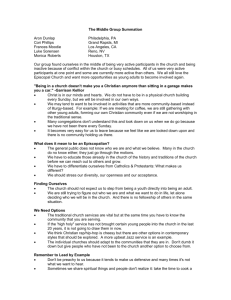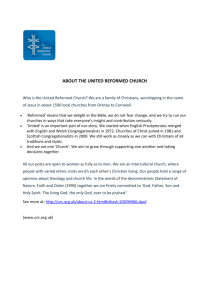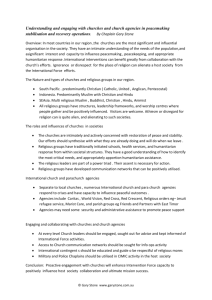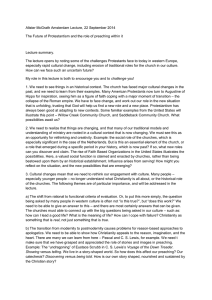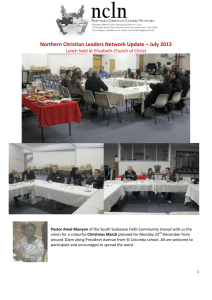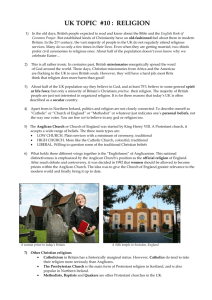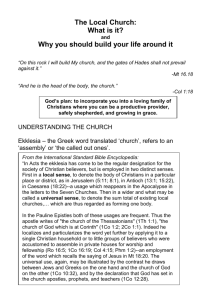HISTORY
advertisement
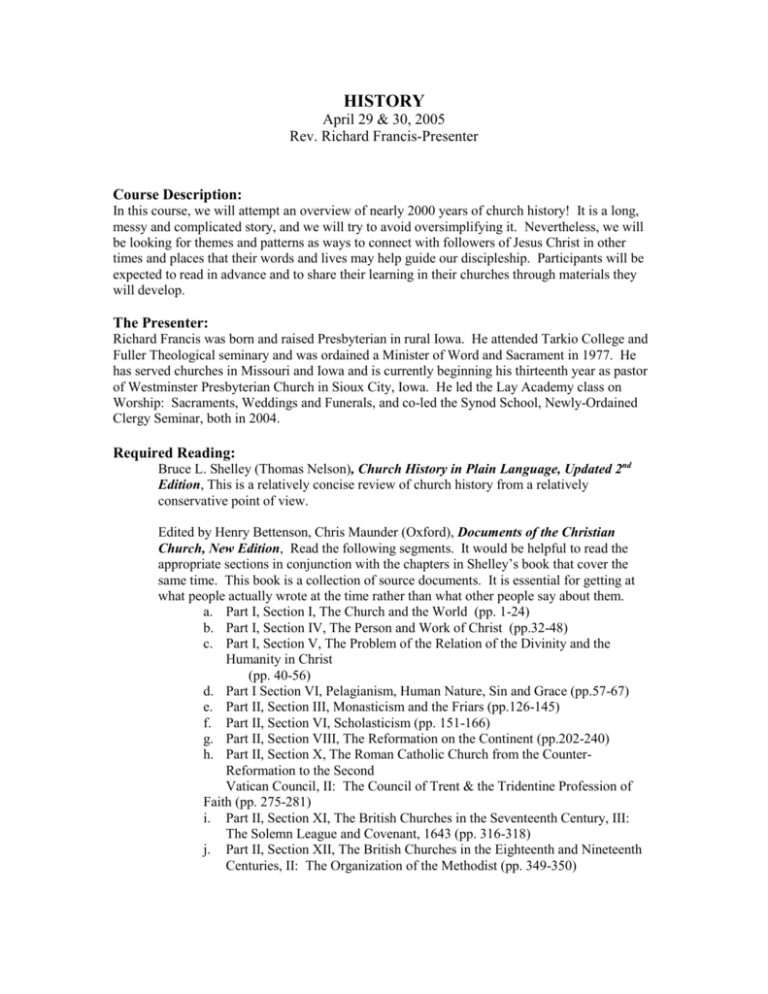
HISTORY April 29 & 30, 2005 Rev. Richard Francis-Presenter Course Description: In this course, we will attempt an overview of nearly 2000 years of church history! It is a long, messy and complicated story, and we will try to avoid oversimplifying it. Nevertheless, we will be looking for themes and patterns as ways to connect with followers of Jesus Christ in other times and places that their words and lives may help guide our discipleship. Participants will be expected to read in advance and to share their learning in their churches through materials they will develop. The Presenter: Richard Francis was born and raised Presbyterian in rural Iowa. He attended Tarkio College and Fuller Theological seminary and was ordained a Minister of Word and Sacrament in 1977. He has served churches in Missouri and Iowa and is currently beginning his thirteenth year as pastor of Westminster Presbyterian Church in Sioux City, Iowa. He led the Lay Academy class on Worship: Sacraments, Weddings and Funerals, and co-led the Synod School, Newly-Ordained Clergy Seminar, both in 2004. Required Reading: Bruce L. Shelley (Thomas Nelson), Church History in Plain Language, Updated 2nd Edition, This is a relatively concise review of church history from a relatively conservative point of view. Edited by Henry Bettenson, Chris Maunder (Oxford), Documents of the Christian Church, New Edition, Read the following segments. It would be helpful to read the appropriate sections in conjunction with the chapters in Shelley’s book that cover the same time. This book is a collection of source documents. It is essential for getting at what people actually wrote at the time rather than what other people say about them. a. Part I, Section I, The Church and the World (pp. 1-24) b. Part I, Section IV, The Person and Work of Christ (pp.32-48) c. Part I, Section V, The Problem of the Relation of the Divinity and the Humanity in Christ (pp. 40-56) d. Part I Section VI, Pelagianism, Human Nature, Sin and Grace (pp.57-67) e. Part II, Section III, Monasticism and the Friars (pp.126-145) f. Part II, Section VI, Scholasticism (pp. 151-166) g. Part II, Section VIII, The Reformation on the Continent (pp.202-240) h. Part II, Section X, The Roman Catholic Church from the CounterReformation to the Second Vatican Council, II: The Council of Trent & the Tridentine Profession of Faith (pp. 275-281) i. Part II, Section XI, The British Churches in the Seventeenth Century, III: The Solemn League and Covenant, 1643 (pp. 316-318) j. Part II, Section XII, The British Churches in the Eighteenth and Nineteenth Centuries, II: The Organization of the Methodist (pp. 349-350) k. Part II, Section XIII, The Roman Catholic Church at the Second Vatican Council (pp. 359-368) l. Part II, Section XIV, The Twentieth-Century World Churches: Justic, Peace, and the Environment 1. II: Resistance in Nazi Germany, pp. 372-374 2. III: Black Theology in the 1960’s: Martin Luther King’s Letter from Birmingham Jail, pp. 375-376 3. IV: The Origins of Liberation Theology, pp. 379-384 4. VII: Feminist Theology, pp. 391-394 m. Part II, Section XVI, The Twentieth Century Churches and Christian Unity 1. III: Taize and Reconciliation, Brother Roger, No Greater Love, pp. 421-422 2. IV: The Church of South India, Basis of Union, 1946, pp.423-425 3. IX: Lutheran-Reformed Relations, Toward Church Fellowship, 1989, p. 435 Recommended Reading: Edited by E.A. Livingstone, The Oxford Concise Dictionary of the Christian Church. A good thing to have within reach if you need to check up on some aspect of church history. Inexpensive, paperback. Edited by John McManners, The Oxford Illustrated History of Christianity. A big beautifully-illustrated paperback with chapters by church historians who are expert in the various periods. Worth dipping into even if you don’t read it cover to cover. Pre-Course Assignment: Read the books listed above. Post Assignment: Choose one of the following: 1. Research one period in church history or one figure in church history that you found particularly interesting. Present your findings as a series of 2-3 Sunday school lessons for either adults of senior highs. Be sure to draw contemporary applications from the historical events. Charts, diagrams and pictures are a plus. 2. Develop either a 90-minute session or two 60-minute sessions on church history to be presented to a Confirmation class. Charts, diagrams and pictures are a plus. 3. Write three sermons on texts of your own choosing: a. A Reformation Day sermon that reflects one issue or event of the Protestant Reformation from a Reformed perspective. b. An All Saints’ Day Sermon that reflects on our common Christian heritage from a Reformed perspective. c. A Christian Unity Day sermon for an ecumenical gathering that gives your understanding of Christian unity from a Reformed perspective.
